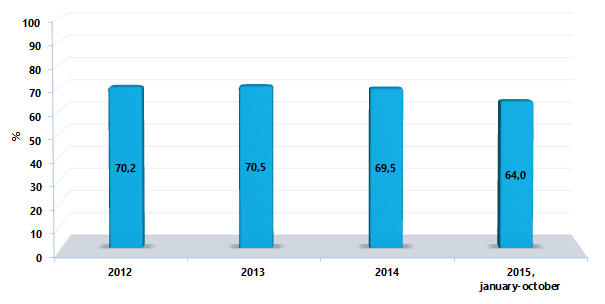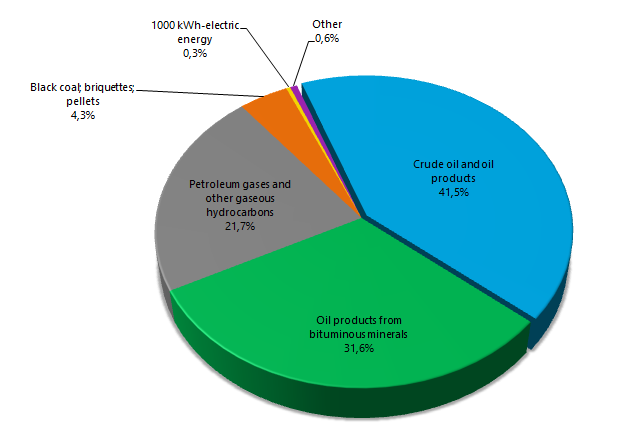Fuel and energy export of Russia: volumes, structure, dynamics
The past year has challenged the Russian economy and federal budget: the country has entered the period of unprecedented low prices on fuel and energy goods being the main export items.
Oil price has reduced to the 12-years minimum level; and this negative tendency will be hardly changed in the current conditions. Keeping the OPEC quota on the same extraction level, the impact of OPEC leaders Saudi Arabia and the UAE, maximum raw materials stock of the USA, entering the foreign markets of Iranian and American oil, contraband supplies from Syria and Iraq and the general slowdown in the world economy make the forecasting on the raw materials quotation quite conventional.Reduction in extraction of shale oil, withdrawal from the market of the majority of shale producing companies, as well as inadequate investment in the oil industry (because of low quota) will finally lead to reduction in supply. However, no one could predict when this happens.
This raises the question of whether Russia is so depend on oil and gas export. What is the structure of oil and gas export?
First of all the following should be noted: in January – October 2015 the supplies of oil and gas products to the foreign markets came first and reached 184,9 bln dollars in monetary term, that is 64% of total export of the country. In January – October 2014 the share of fuel goods was 70,7% of total export. However, the decrease in export in November – December 2014 has reduced the annual rate to 69,5%. So, the share of oil and gas products export has fallen by 6,7% during the year.

Picture 1. Share of fuel and energy goods in monetary terms in the general export structure, %
In January – October 2014, the export of fuel and energy goods has reduced by 38,2% (299,2 bln dollars) in monetary term. The ruble devaluation has compensated the revenue reduction and let to increase supplies in volume term to the foreign market; supplies to China were double increased.
«In 2015 oil export from Russia will increase by 7,5% (to 238 mln tons) in comparison with the previous year. Oil extraction will reach the record 533,6 mln tons, that is 1,3% higher than in the previous year. Oil offshore production will increase by 16% (to 18,8 mln tons)».
Aleksandr Novak, Minister of energy of the Russian Federation, December 24, 2015.
The reduction of fuel resources share in the total export is not explained with decrease in volume term supplies. The reverse process of increase in supplies to the foreign markets takes place. Today the export restructuring in favor of other commodity groups and items of income is observed.
The structure of fuel and energy goods export disproves the ingrained vision of Russia as a country producing nothing but oil. Only 41,5% of export in monetary term fall to the share of crude oil; 31,6% for the share of recycling oil products with high added value – gasoline, white-spirit, kerosene, gas oils, black oil, spindle and lubricating oils, white oils; 21,7% goes for natural gas and 4,3% for black coal (see Pic. 2).

Picture 2. Commodity structure of fuel and energy goods export, January – October 2015, % of monetary term
The Credinform experts consider the continuation of commodity structure diversification under the conditions of low ruble. The producer oriented on foreign markets has already got competitive advantage due to the reduction of the final offer cost for foreign counterparties. Russian producers of grain, metals, fertilizers and weaponry have already marked changes and expand their presence abroad.
Fines for unfiled bankruptcy petition
Information agency Credinform always pays attention to bankruptcies. There are more than a dozen of articles on this topic on our web-site. For example, in October 2015 we have covered the bankruptcy issue in the articles “Оn individual bankruptcy” and “Individual bankruptcy - new reality for the Russian economy”.
The legislation on bankruptcy was appended with the enforceable Federal Law N 353-FL “On amendments to the Civil Procedure Code of the Russian Federation” of December 12, 2010.
The amendments to the “Code of Administrative Offences of the Russian Federation” N 195-FL of December 30, 2001 (as last amended on 30.12.2015) were accepted and aimed at toughen up the administrative responsibility for unfiled bankruptcy petition by natural persons and legal entities. The Federal tax service amerces from 1 to 3 thousand rubles for individuals and from 5 to 10 thousand rubles for public officials committed an offense. In case of repetition of the violation throughout the year, the arbitral tribunal has the right to disqualify the guilty persons on the proposal of the tax authorities.
Following the amendments, the persons supervising the debtor can also be disqualified by judicial decision. This is possible if there is a protocol on administrative offense of non-performing the judicial act to bring to vicarious liability. Tax authorities are now endowed with the right to establish such protocols.
These amendments also downgrade for breaches of bankruptcy procedures legislated in the Federal Law N 127-FL “On Insolvency (Bankruptcy)” of October 26, 2002, as well as for non-performance the obligation to file the bankruptcy petition to the arbitration court by the debtor. This applies to professional participants of the bankruptcy proceedings, including arbitration managers. For the first breach a warning will be given, and for the violation repeated during a year disqualification can be followed.
Moreover, the Federal Law “On Insolvency (Bankruptcy)” was amended in bankruptcies of real estate developers and citizens-debtors. Conditions for the repayment of participants’ requirements through the transfer of unfinished construction of the facility were simplified. The list of information about the bankruptcy of a citizen for publication was arranged. The conditions and procedure of bankruptcy of a citizen and the distribution of his property with a notary in case of the citizen-debtor’s death were specified.
For information:
According to the Federal tax service, 221 806 legal entities and 14 128 individual entrepreneurs (farms in form of individual private enterprise) have ceased their activities for bankruptcy for the whole monitoring period, including the year 2015 with 11 213 bankrupted legal entities and 1 926 individual entrepreneurs and farms in form of individual private enterprise.
Following the same source, 4 820 432 active legal entities and 3 640 230 individual entrepreneurs (farms in form of individual private enterprise) are registered in Russia as of January 1, 2016. All information about active and bankrupted companies is available by subscription on the Information and analytical system Globas-i®.